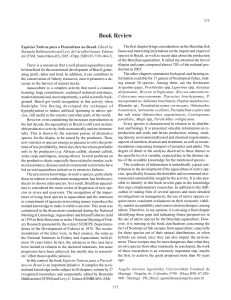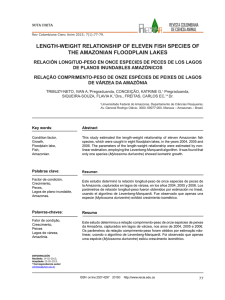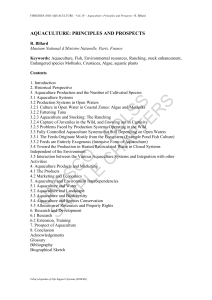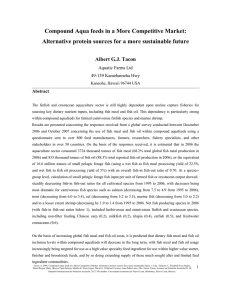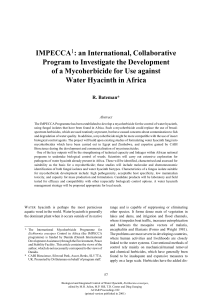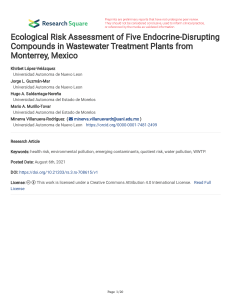Biofilter efficiency of Eichhornia crassipes in wastewater
Anuncio
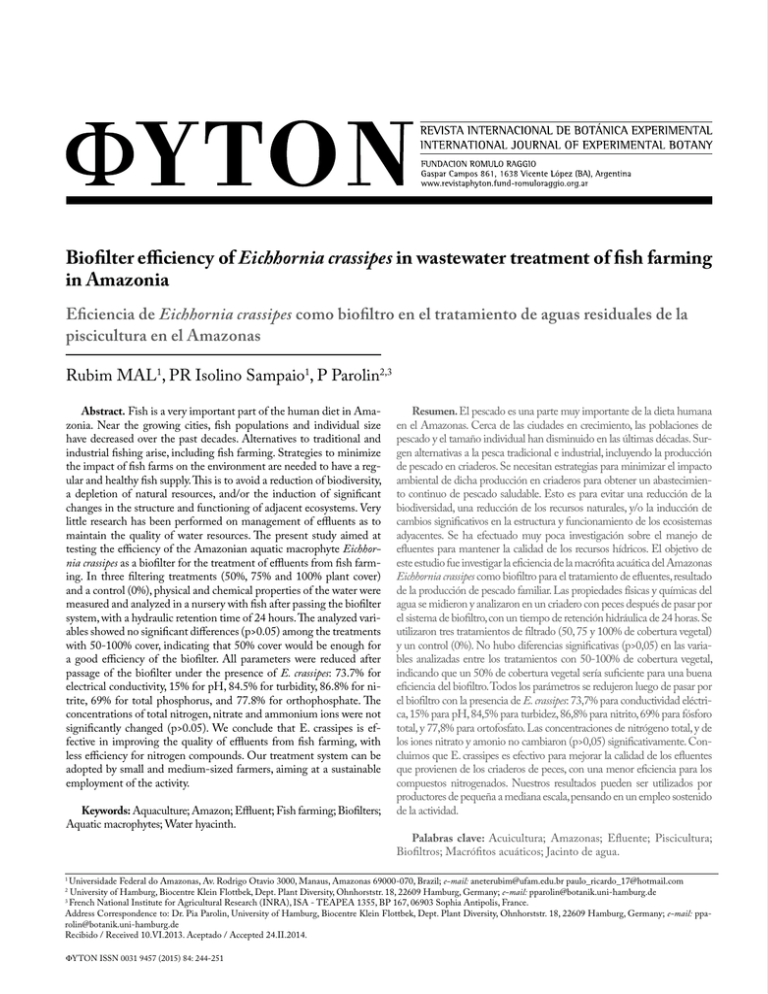
Biofilter efficiency of Eichhornia crassipes in wastewater treatment of fish farming in Amazonia Eficiencia de Eichhornia crassipes como biofiltro en el tratamiento de aguas residuales de la piscicultura en el Amazonas Rubim MAL1, PR Isolino Sampaio1, P Parolin2,3 Abstract. Fish is a very important part of the human diet in Amazonia. Near the growing cities, fish populations and individual size have decreased over the past decades. Alternatives to traditional and industrial fishing arise, including fish farming. Strategies to minimize the impact of fish farms on the environment are needed to have a regular and healthy fish supply. This is to avoid a reduction of biodiversity, a depletion of natural resources, and/or the induction of significant changes in the structure and functioning of adjacent ecosystems. Very little research has been performed on management of effluents as to maintain the quality of water resources. The present study aimed at testing the efficiency of the Amazonian aquatic macrophyte Eichhornia crassipes as a biofilter for the treatment of effluents from fish farming. In three filtering treatments (50%, 75% and 100% plant cover) and a control (0%), physical and chemical properties of the water were measured and analyzed in a nursery with fish after passing the biofilter system, with a hydraulic retention time of 24 hours. The analyzed variables showed no significant differences (p>0.05) among the treatments with 50-100% cover, indicating that 50% cover would be enough for a good efficiency of the biofilter. All parameters were reduced after passage of the biofilter under the presence of E. crassipes: 73.7% for electrical conductivity, 15% for pH, 84.5% for turbidity, 86.8% for nitrite, 69% for total phosphorus, and 77.8% for orthophosphate. The concentrations of total nitrogen, nitrate and ammonium ions were not significantly changed (p>0.05). We conclude that E. crassipes is effective in improving the quality of effluents from fish farming, with less efficiency for nitrogen compounds. Our treatment system can be adopted by small and medium-sized farmers, aiming at a sustainable employment of the activity. Keywords: Aquaculture; Amazon; Effluent; Fish farming; Biofilters; Aquatic macrophytes; Water hyacinth. Resumen. El pescado es una parte muy importante de la dieta humana en el Amazonas. Cerca de las ciudades en crecimiento, las poblaciones de pescado y el tamaño individual han disminuido en las últimas décadas. Surgen alternativas a la pesca tradicional e industrial, incluyendo la producción de pescado en criaderos. Se necesitan estrategias para minimizar el impacto ambiental de dicha producción en criaderos para obtener un abastecimiento continuo de pescado saludable. Esto es para evitar una reducción de la biodiversidad, una reducción de los recursos naturales, y/o la inducción de cambios significativos en la estructura y funcionamiento de los ecosistemas adyacentes. Se ha efectuado muy poca investigación sobre el manejo de efluentes para mantener la calidad de los recursos hídricos. El objetivo de este estudio fue investigar la eficiencia de la macrófita acuática del Amazonas Eichhornia crassipes como biofiltro para el tratamiento de efluentes, resultado de la producción de pescado familiar. Las propiedades físicas y químicas del agua se midieron y analizaron en un criadero con peces después de pasar por el sistema de biofiltro, con un tiempo de retención hidráulica de 24 horas. Se utilizaron tres tratamientos de filtrado (50, 75 y 100% de cobertura vegetal) y un control (0%). No hubo diferencias significativas (p>0,05) en las variables analizadas entre los tratamientos con 50-100% de cobertura vegetal, indicando que un 50% de cobertura vegetal sería suficiente para una buena eficiencia del biofiltro. Todos los parámetros se redujeron luego de pasar por el biofiltro con la presencia de E. crassipes: 73,7% para conductividad eléctrica, 15% para pH, 84,5% para turbidez, 86,8% para nitrito, 69% para fósforo total, y 77,8% para ortofosfato. Las concentraciones de nitrógeno total, y de los iones nitrato y amonio no cambiaron (p>0,05) significativamente. Concluimos que E. crassipes es efectivo para mejorar la calidad de los efluentes que provienen de los criaderos de peces, con una menor eficiencia para los compuestos nitrogenados. Nuestros resultados pueden ser utilizados por productores de pequeña a mediana escala, pensando en un empleo sostenido de la actividad. Palabras clave: Acuicultura; Amazonas; Efluente; Piscicultura; Biofiltros; Macrófitos acuáticos; Jacinto de agua. Universidade Federal do Amazonas, Av. Rodrigo Otavio 3000, Manaus, Amazonas 69000-070, Brazil; e-mail: aneterubim@ufam.edu.br paulo_ricardo_17@hotmail.com University of Hamburg, Biocentre Klein Flottbek, Dept. Plant Diversity, Ohnhorststr. 18, 22609 Hamburg, Germany; e-mail: pparolin@botanik.uni-hamburg.de 3 French National Institute for Agricultural Research (INRA), ISA - TEAPEA 1355, BP 167, 06903 Sophia Antipolis, France. Address Correspondence to: Dr. Pia Parolin, University of Hamburg, Biocentre Klein Flottbek, Dept. Plant Diversity, Ohnhorststr. 18, 22609 Hamburg, Germany; e-mail: pparolin@botanik.uni-hamburg.de Recibido / Received 10.VI.2013. Aceptado / Accepted 24.II.2014. 1 2 FYTON ISSN 0031 9457 (2015) 84: 244-251 Eichhornia crassipes as biofilter for wastewater INTRODUCTION Aquaculture is developing in the Amazon region over the past decades. It is gaining importance due to (1) the high and continuous reduction of natural fish stocks, and (2) many positive factors naturally available, such as abundance of water, climatic conditions and increased demands for fish. In the State of Amazonas, this demand is basically favored by the high consumption of fish by the local population, one of the biggest consumers of fish in the world (Soares & Junk, 2000). On average, 160 g of fish per capita per day are consumed in the city of Manaus, and more than 500 g per capita per day in the rural zones of Central Amazonia, with a maximum of 805 g per capita per day recorded in Rio Japurá (Batista et al., 1998, Freitas et al., 2012). Thus, fish is a major source of protein in a region with a fast growing population (Soares & Junk, 2000). Highly abundant fish stocks of several species have supported an important fishery for many decades (Freitas et al., 2012). However, the abundance and size of fishes is shrinking due to environmental changes and man-made interventions. As a result, an integrative strategy for fishery management is missing (Soares & Junk, 2000, Freitas et al., 2012). Thus, aquaculture is a promising alternative to fisheries. However, fish farming in aquaculture is a potential polluting activity, and causes several adverse effects to the environment (Pillay, 1992; Jegatheesan et al., 2011). Fish are concentrated in high densities and receive continuous food supply. This leads to high concentrations of nutrients and organic residues in the water system causing eutrophication and changes of species composition and abundance of various aquatic organisms (Bird, 1993). Suspended solids, dissolved organic substances, compounds of nitrogen and phosphorus, and other chemicals accumulate ( Jegatheesan et al., 2011). Because of this, fish farming generates effluents which affect the surrounding ecosystems after disposal of the nursery waters (Castellani & Barrella, 2005). The ecosystems where aquaculture is inserted must be preserved to have a regular and healthy fish supply (Garutti, 2003). Strategies to minimize the impact of fish farms on the environment are needed to avoid (1) a reduction of biodiversity, (2) a depletion of natural resources, and (3) an induction of significant changes in the structure and functioning of adjacent ecosystems (Pádua, 2001; Dosdat, 2002). The relationships between the activities of aquaculture and the environment are of significant economic importance (Black, 2001). Maintenance of a good water quality is critical to achieve satisfactory production levels in aquaculture ( Jegatheesan et al., 2011). The sustainability in its performance and preservation of the surrounding environment are highly relevant, besides focusing on aspects of production, income, and social development (Maciel & Valenti, 2009). In the Amazon, aquaculture in constructed wetlands does not have a long tradition (Soares & Junk, 2000). It is limited by the required physical and technical infrastructure, and op- 245 erational costs (Santos & Santos, 2005). At present, no surveys are available which analyze fish farming in the Amazon, nor the influence of effluents and their potential treatments to minimize possible impacts on the receiving water bodies in Amazonian ecosystems. Research on this whole field is needed to (1) assess information about the management of effluents to maintain the quality of water resources, and (2) subsidize public policies for this sector. In this paper, we focused on the use of local plants for the treatment of effluent wastewaters. This is because one way to increase the quality of the effluents is using floating plants as biofilters (Schwartz & Boyd, 1995; Tilley et al., 2002; Hussar et al., 2005, Henry-Silva & Camargo, 2006; Jegatheesan et al., 2011, Buhmann & Papenbrock, 2012). Local Amazonian macrophytes such as Eichhornia crassipes are efficient biofilters in Amazonia (Roquete Pinto et al., 1993; Roquete Pinto & Pereira, 2000; Sipaúba-Tavares et al., 2002; Henry-Silva & Camargo, 2006, 2008) and around the world (Tiwari et al., 2007; Akinbile & Yussoff, 2012). Water hyacinth is considered as the most efficient aquatic plant used in removing a vast range of pollutants such as organic matter, nutrients and heavy metals (Kutty et al., 2009). However, there is still a lack of knowledge about the efficiency of Eichhornia crassipes, and its practical application, as a result of its extremely fast growth (Sculthorpe, 1985; Madsen, 1993). This is related to a rapid covering of the water surfaces, which in nature and aquaculture plays an enormous role for the fauna and water quality (e.g., oxygen, light) in the underneath water body. Therefore, our study aimed at evaluating the effect of Eichhornia crassipes as biofilter. Various percentage cover of this species were used in aquaculture for the local Amazonian fish Brycon amazonicus Spix and Agassiz, an important protein resource in the Amazonian diet (Lovshin et al., 1997). MATERIALS AND METHODS We performed an experiment at the Amazon Research Institute (INPA), Manaus, Brazil, using a completely randomized design with four treatments (T), each with three repetitions: T1 = 100% plant cover; T2 = 75%; T3 = 50%; T4 = 0% (control, without vegetation cover). The fresh weight biomass of E. crassipes corresponding to each treatment was: T1 = 9.60 ± 0.56 kg; T2 = 7.20 ± 0.42; T3 = 4.80± 0.28 kg; T4 = 0 kg. The nursery covered an area of 144 m2, whose effluent was drained and distributed to the biofilter system through 25 mm PVC pipes (Fig. 1). The macrophytes were collected in a natural protected environment in the municipality of Manacapuru, Amazonas, Brazil, and transported to the site of the experiment in plastic buckets. We collected young individuals of E. crassipes. The experimental units were composed of fiberglass tanks (3.7 x 0.45 m, 0.20 m high). The effluent retention period in each FYTON ISSN 0031 9457 (2015) 84: 244-251 246 Rubim MAL et al., FYTON 84 (2015) Fig. 1. Experimental setting. Fig. 1. Diseño experimental. tank was 24 hours. The efficiency of the system was evaluated through measures and analyses of physical and chemical variables of wastewater. The focal fish was Brycon amazonicus Spix and Agassiz, matrinxã in the local language (Lovshin et al., 1997). Stocking density was 32 fish weighing between 1 and 1.5 kg, fed daily with 3 to 4 kg of extruded commercial ration containing 40% crude protein. Physical and chemical parameters of the water. We measured several variables in the treatments with different plant cover and in the effluent of the nursery. pH, electrical conductivity and turbidity were assessed with portable equipments (Quimis Q400A, GEHAKA CG-220, and POLILAB, respectively). The methodology for the determination of total N was adapted from APHA (2005), and ammonium was measured by the Nessler method. Nitrate (NO3) was reduced to nitrite (NO2−) by using a cadmium amalgam column and subsequent digital spectrophotometry (Sigma, 20 Genesys, sensitivity limit 0.01 mg/L) analyses using the method of GrassFYTON ISSN 0031 9457 (2015) 84: 244-251 hoff. Ortho-P and P-total were analyzed by colorimetry with ascorbic acid in a digital spectrophotometer (λ = 882 nm). The data were subjected to analysis of variance (ANOVA) and Tukey’s test for comparison of averages of physical and chemical variables between treatments, using a significance level of 5% (p=0.05). The tests were carried out using the statistical program ASSISTAT 7.5 beta version. RESULTS Physical and chemical parameters of the effluents from the nursery differed significantly from the control treatments (Fig. 2, Table 1). The treatments with 100%, 75% and 50% of coverage with the aquatic macrophyte E. crassipes did not present significant differences between them (Table 1). The pH of the nursery water was slightly alkaline. After passage through the biofilter, the effluent was more acid. All treatments had a strong influence on pH, the 75% coverage had the highest influence on pH reductions as compared to the control (Table 1). Eichhornia crassipes as biofilter for wastewater 247 Table 1. Average ± standard deviation for the physical and chemical variables in each treatment and in the effluent. Means followed by the same letter are not statistically different from each other. Tukey test was applied with 5% level of probability. Tabla 1. Promedio ± desviación estándar para las variables físicas y químicas en cada tratamiento y en el efluente. Los promedios seguidos por la misma letra no difieren estadísticamente. Se aplicó la prueba de Tukey con un 5% de probabilidad. Limnological parameter pH Effluent from nursery 7.69 ± 1.33 Control (0%) 6.37 ± 0.35 Conductivity (µ/S/cm) 41.47 ± 24.78 26.12 ± 15.04 Nitrite NO2- (mg/L) 0.126 ± 0.014 0.029 ± 0.028 Turbidity (NTU) Nitrate NO3- (mg/L) Ammonium NH4+ (mg/L) 8.80 ± 5.52 0.392 ± 0.212 0.256 ± 0.091 a 0.019 ± 0.014 0.021 ± 0.022 a 0.110 ± 0.046 1.087 ± 0.533 P-Ortho (mg/L) 0.047 ± 0.013 0.046 ± 0.013 0.063 ± 0.016 12.40 ± 15.04 a 1.994 ± 1.055 0.059 ± 0.014 Turbidity differed significantly (p>0.05) between treatments and control (4.92 Nephelometric Turbidity Unit NTU). The lowest value was found with 50% coverage (1.36 NTU). Differences between the three coverage treatments were small and not significant, all treatments showing low turbidity values. The same pattern of variation was observed for electric conductivity, where significant differences were found between the control and the treatments, but the three coverage treatments gave similar results. Nitrite presented the lowest content (0.017 mg/L) in the treatment with 75% of coverage (Table 1). Nitrate, ammonia and NT did not differ among treatments (Fig. 2). The levels of phosphate compounds were strongly reduced after passing the biofilter, both P-total (0.059 - 0.004 mg/L) and P-Ortho (0.046 - 0.002 mg/L) without significant differences in the three treatments (Table 1). DISCUSSION The use of Eichhornia crassipes as biofilter proved to be efficient in our experiments and is promising for the treatment of effluents from fish farming in constructed wetlands in Amazonia. We found good results in the removal of polluting compounds contained in the effluents, especially related to phosphate compounds, nitrite, pH and turbidity. The efficiency of E. crassipes is probably associated with the huge development of the root system (Debusk et al., 1989). Henry-Silva and Camargo (2006) observed 90% reduction of turbidity in areas colonized by E. crassipes, and Lin et al. (2005) described 99%, with turbidity values below 0.2 NTU and never higher than 0.8 NTU. Both studies related this to the root system. Even small amounts of plants have a large root biomass. Therefore, 100% 5.45 ± 0.45 a 4.92 ± 3.64 N-total (mg/L) P-total (mg/L) a a a a a Treatment b b 10.92 ± 3.09 b 0.017 ± 0.013 a 0.138 ± 0.167 1.66 ± 0.75 b 0.031 ± 0.018 a 0.093 ± 0.056 0.851 ± 0.574 0.019 ± 0.004 0.010 ± 0.004 75% 5.43 ± 0.39 a b b b b 1.52 ± 0.66 b 0.030 ± 0.018 a 0.834 ± 0.630 0.020 ± 0.005 0.011 ± 0.002 50% 5.47 ± 0.42 11.52 ± 5.58 a b 1.36 ± 0.83 b 0.021 ± 0.011 a b 0.019 ± 0.013 a b 0.088 ± 0.074 0.798 ± 0.634 b 0.019 ± 0.004 b 0.010 ± 0.003 b a a b b a small coverage of the water surface (50%) with E. crassipes is sufficient given that higher coverages did not have further positive impacts on water quality. Changes of pH and conductivity. The observed reductions of pH in the effluent after treatment might be related to the presence of micro-organisms associated with the rhizosphere of the macrophytes, which would cause changes of the surrounding pH through the processes of respiration and decomposition (Wolverton, 1989; Lin et al., 2005). The slightly acidic characteristics of the water after the treatment, which would eventually be released into the natural environment, is congruent with the natural characteristics of waters of small rivers in Amazonia. Electrical conductivity is influenced by the presence of macronutrients (calcium, magnesium, potassium, sodium, chloride, sulfate, carbonate). The observed decrease after biofilter passage might be attributed to the use of these macronutrients in the metabolism of plants which absorb them from the aquatic environment. Boyd (1990) points out that high concentrations of calcium and magnesium help in coagulation and precipitation of colloids favoring growth. Changes of nitrogen- and phosphorus-related compounds. Uptake of nitrogen-related compounds as well as phosphorus-related compounds by aquatic macrophytes varies strongly from species to species (Sculthorpe, 1985), and happens through the root system. In our experiment, total nitrogen, nitrate, and ammonia were not significantly influenced by the presence of E. crassipes. Other macrophytes, such as Elodea densa, remove approximately 25% of nitrogenous forms (Nammonia, N-nitrite and N-nitrate) of effluents from aquaculture with ornamental fish (Ng et al., 1990). Kutty et al. (2009) found that in Malaysia where E. crassipes was used for filtering FYTON ISSN 0031 9457 (2015) 84: 244-251 248 FYTON ISSN 0031 9457 (2015) 84: 244-251 Rubim MAL et al., FYTON 84 (2015) Eichhornia crassipes as biofilter for wastewater 249 Fig. 2. (A) Electrical conductivity (µ/S/cm) and pH; (B) turbidity (NTU) and nitrite (mg/L); (C) nitrate and N-total (mg/L); (D) ammonia and P-total (mg/L) in the effluent of the nursery and the different treatments. Fig. 2. (A) Conductividad (µ/S/cm) y pH; (B) turbidez (NTU) y nitritos (mg/L); (C) nitratos y N total (mg/L); (D) amoníaco y P total (mg/L) en el efluente y en los distintos tratamientos. effluent municipal wastewater, 81% of ammonia and 92% of nitrate were reduced by the plant. Petrucio and Esteves (2000) analysed Eichhornia crassipes in subtropical Brazil, where it exhibited the highest rates of nitrate and ammonia reduction in the water. This indicates that E. crassipes has the potential to do it. However, under the conditions of our experiment it was not as efficient in reducing the concentration of these ions as it showed to be in other experiments. This might be the result of a reduced presence of nitrogen-fixing bacteria that live in semi-symbiosis or in the rhizosphere of plants (Patriquim & Knowles, 1970). It was observed that nitrogen is not fixed unless E. crassipes suffers extreme nitrogen deficiency (Purchase, 1977), and therefore N-compounds are accumulated. Nitrite was reduced by 42% by the activity of E. crassipes. This was also observed by Henry-Silva and Camargo (2006), with 36.2% reductions, and by Schwartz and Boyd (1995) with 43-98% reductions. Nitrite is toxic to fish, especially in an environment where high temperature and daily fluctuations in dissolved oxygen may aggravate nitrite intoxication (Costa et al., 2004). Eichhornia crassipes should be able to prevent that the fish’s performance be compromised in aquaculture by efficiently reducing nitrite. Orthophosphate (P-Ortho) was reduced by up to 77% and total phosphorus (P-total) by 68%, independent of plant cover percentage. Similar reductions (71.8% and 82.0%, respectively) were observed by Henry-Silva and Camargo (2006). Phosphorus removal was considerably higher than in other systems used for the treatment of effluents (DeBusk et al., 1983). In our study, E. crassipes was less efficient in the removal of nitrogenous than phosphate forms. The same was noted by Henry-Silva and Camargo (2006), although some authors report that the species is more efficient at removing nitrogenous forms (Dunigan et al., 1975; Sooknah & Wilkie, 2004). IMPLICATIONS Aquaculture is a promising alternative to the exploitation of different species of fish, shrimps, or other aquatic protein sources. However, management plans are needed in order to assure long-term sustainability (Maciel & Valenti, 2009). As a result, the control and cleaning of the wastewater is imperative. Our results showed the efficiency of the aquatic macrophyte Eichhornia crassipes to reduce nutrient concentrations and the amount of particulate organic material in the effluent of fish farming. Statistical analysis showed that the different percentages of coverage (50%, 75% and 100%) with the macrophyte showed no differences between them. Therefore we conclude that the treatment with lowest vegetation cover (50%) is sufficient for improving the quality of the effluent under the given environmental conditions. The use of biofilters can be adopted in fish farms of small and medium businesses considering the low cost of deployment. They also contribute to minimize the impact on water resources. It is important to emphasize that the adoption of this technique may prevent potential conflicts about multiple uses of water resources in areas of fish production in the Amazon region. Freshwater usually is not a FYTON ISSN 0031 9457 (2015) 84: 244-251 250 limiting resource in the Amazon basin, but this may change for some periods of the year because of recurring and increasing periods of drought (Laurance et al., 2002; IPCC, 2007; Marengo et al., 2008; Phillips et al., 2009). One important aspect to consider if growing E. crassipes outside of its native area of distribution, is that this species is highly invasive. As a result, it already represents a major threat in wetlands all over the world (Vietmayer, 1975; Holm et al., 1977; Oberholzer, 2002; Parolin et al., 2010, 2012). It outcompetes local species by its immense growth rates, covering natural wetlands with large monocultures and thus reducing biodiversity (Gowanloch, 1944; Holm et al., 1977; Gutierrez et al., 2001; Parolin et al., 2012). Therefore, we recommend that Eichhornia crassipes should be employed only in Amazonia, and that other local, fast-growing macrophyte species be tested for their use as biofilters in aquaculture in other continents. The implementation of well-managed and controlled aquaculture systems may have an overall positive impact. Human population growth and an increasing demand for food (fish protein) in the region is a fact. In order to limit deforestation and land degradation in Amazonia (Fearnside, 2005), fish farms may provide serious alternative income and protein sources, and play an important role in the future. As long as efforts to mitigate detrimental environmental effects are undertaken, aquaculture may even reduce deforestation significantly. This is especially true in areas where soils provide only a few years of crop production (Halpern, 2012). As recently analysed for the Peruvian lowlands, aquaculture has the potential to reduce deforestation in the Amazon: “An extra square meter of aquaculture reduces the area deforested for crops on approximately a one for one basis. However, aquaculture should maintain its productivity for much longer than cropping, as it does not depend on soils whose fertility can be exhausted in a few years. Our simulations, based on our survey results, indicate that over time aquaculture should reduce deforestation significantly” (Halpern, 2012). ACKNOWLEDGEMENTS We thank the Fundação de Amparo à Pesquisa do Estado do Amazonas (FAPEAM) for financial support. REFERENCES Akinbile, C.O. & M.S. Yussof (2012). Assessing water hyacinth (Eichhornia crassipes) and lettuce (Pistia stratiotes) effectiveness in aquaculture wastewater treatment. International Journal of Phytoremediation 14: 201-11. APHA, American Public Health Association (2005). Standard methods for the examination of water and wastewater, Washington: APHA, USA. 1220 p. Batista,V.S., A.J.I. Silva, C.E.C. Freitas & D. Freire-Brasil (1998). Characterization of the fishery in riverine communities in the Low-Solimões/ High-Amazon region. Fisheries Management and Ecology 5: 101-117. FYTON ISSN 0031 9457 (2015) 84: 244-251 Rubim MAL et al., FYTON 84 (2015) Bird, K.T. (1993) Aquatic plants for treatment of aquaculture wastewater. Aquaculture Magazine 19: 39-42. Black, K.D. (2001) Environmental Impacts of Aquaculture. Sheffield Biological Sciences. Sheffield Academic Press. Boyd, C. (1990) Water quality in pond aquaculture. Alabama, Birmingham, USA. Birmingham Publishing. 155 p. Buhmann, A. & J. Papenbrock (2012). Biofiltering of aquaculture effluents by halophytic plants: Basic principles, current uses and future perspectives. Environmental and Experimental Botany 92: 122-133. Castellani, D. & W. Barrella (2005). Characterization of pisciculture in the Vale do Ribeira, SP. Ciência e Agrotecnologia 29: 168-176. Costa, O.T.F., D.J.S. Ferreira, F.L.P. Mendonça & M.N. Fernandes (2004). Susceptibility of the Amazonian fish, Colossoma macropomum (Serrasalminae), to short-term exposure to nitrite. Aquaculture 232: 627-636. DeBusk, T.A., K.R.T. Reddy, D. Hayes & B.R. Schwegler Jr. (1989). Performance of a pilot-scale hyacinth-based secondary treatment system. Water Pollute 30: 174-178. Dosdat, A. (2002). Environmental impacts of aquaculture. In: A. Dosdat (Ed.) Environmental impact of aquaculture. Fisheries and Aquaculture 4: 1-9. Dunigan, E.P. A.R. Phelan & Z.H. Shamsuddin (1975). The use of water hyacinths to remove nitrogen and phosphorus from eutrophication waters. Hyacinth Control Journal 13: 59-62. Fearnside, P.M. (2005) Deforestation in Brazilian Amazonia: History, Rates, and Consequences. Conservation Biology 19: 680-688. Freitas, C.E.C., A.A.F. Rivas, C.P. Campos, I. Sant’Ana, J.R. Kahn, M.A.A. Correa & M.F. Catarino (2012). The potential impacts of global climatic changes and dams on Amazonian fish and their fisheries. New Advances and Contributions to Fish Biology, Türker H. (Ed.) Garutti, V. (2003). Ecological pisciculture. São Paulo, SP, BR. Ed. UNESP. 276 p. Gowanloch, J.N. (1944). The econimc status of water-hyacinth in Louisiana. La Conservation 2: 3-8. Gutiérrez, E.L., E.F. Ruiz, E.G. Uribe & J.M. Martínez (2001). Biomass and productivity of water hyacinth and their application in control programs. Biological and Integrated Control of Water Hyacinth, Eichhornia crassipes. Proceedings of the Second Meeting of the Global Working Group for the Biological and Integrated Control of Water Hyacinth, Beijing, China, 9-12 October 2000. Editors: M.H. Julien, M.P. Hill, T.D. Center and Ding Jianqing. 102: 109-119. Halpern, G. (2012). Aquaculture and Deforestation in the Peruvian Amazon. Pomona Senior Theses 40: 1-653. Henry-Silva, G.G. & A.F.M. Camargo (2006). Efficiency of aquatic macrophytes to treat Nile tilapia pond effluents. Scientia Agricola 3: 433-438. Henry-Silva, G.G. & A.F.M. Camargo (2008). Treatment of shrimp effluents by free-floating aquatic macrophytes. Revista Brasileira de Zootecnia 37: 181-188. Holm, L.G., D.L. Plucknett, J.V. Pancho & J.P. Herberger (1977). The world’s worst weeds: Distribution and Biology. East-West Center/University Press of Hawaii. pp. 72-77. Hussar, G.J., A.L. Paradela, T.C. Jonas & J.P. Rodrigues (2005). Constructed wetland on waste water treatment of fish water: physical and chemical quality analysis. Engenharia Ambiental 2: 46-59. Eichhornia crassipes as biofilter for wastewater IPCC (2007). Intergovernmental panel on climate change. AR4 Synthesis report. http: //www.ipcc.ch/ Jegatheesan, V., L. Shu & C. Visvanathan (2011). Aquaculture Effluent: Impacts and Remedies for Protecting the Environment and Human Health. Encyclopedia of Environmental Health 2011: 123-135. Kutty, S.R.M., S.N.I. Ngatenah, M.H. Isa & A. Malakahmad (2009). Nutrients removal from municipal wastewater treatment plant effluent using Eichhornia crassipes. World Academy of Science, Engineering and Technology 60: 826-831. Laurance, W.F., G. Powell & L. Hansen (2002). A precarious future for Amazonia. TREE 17: 251-252. Lin, Y.F., S.R. Jing, D.Y. Lee, Y.F. Chang, Y.M. Chen & K.C. Shih (2005). Performance of a constructed wetland treating intensive shrimp aquaculture wastewater under high hydraulic loading rate. Environment and Pollution 134: 411-421. Lovshin, L.L., R. Wallace, F. Kubitza & R.B. Barthem (1997). Capture fishery and aquaculture potential in the State of Amapá, Brazil. Water Harvesting and Aquaculture for Rural Development Series: An Introduction to Aquaculture. pp. 1-57. Maciel, C.R. & W.C. Valenti (2009). Biology, Fisheries, and Aquaculture of the Amazon River Prawn Macrobrachium amazonicum: A Review. Nauplius 17: 61-79. Madsen, J.D. (1993). Growth and biomass allocation patterns during waterhyacinth mat development. Journal of Aquatic Plant Management 31: 134-137. Marengo, J.A., C.A. Nobre, J. Tomasella, M.D. Oyama, G.S. Oliveira, R. Oliveira, H. Camargo, L.M. Alves & I.F. Brown (2008). The drought of Amazonia in 2005. Journal of Climate 21: 495-516. NG, W.J., T.S. Sim & K.K. Ong (1990). The effect of Elodea densa on aquaculture water quality. Aquaculture 87: 267-276. Oberholzer, I.G. (2002). Project to Conserve Water Resources: ARC-PPRI Scientists Visit China. Plant Protection News 61: 1011. Pádua, H.B. (2001). Environmental impact: an impact on aquaculture. Revista Brasileira de Agropecuária 1: 1-66. Parolin, P., B. Rudolph, S. Bartel & W.J. Junk (2010). The beautiful water hyacinth Eichhornia crassipes and the role of botanical gardens in the spread of an aggressive invader. Bollettino dei Musei e degli Istituti Biologici dell’Università di Genova 72: 56-66. Parolin, P., B. Rudolph, S. Bartel, C. Bresch & C. Poncet (2012). Worldwide invasion pathways of the South American Eichhornia crassipes. Acta Horticulturae 937: 1133-1140. Patriquim, D. & R. Knowles (1970). Nitrogen fixation in the rizosphere of marine angiosperms. Marine Biology 16: 49-58. Petrucio, M.M. & F.A. Esteves (2000). Uptake rates of nitrogen and phosphorus in the water by Eichhornia crassipes and Salvinia auriculata. Revista Brasileira de Biologia 60: 229-236. Phillips, O.L., L.E.O.C. Aragao, S.L. Lewis, J.B. Fisher et al. (2009). Drought Sensitivity of the Amazon Rainforest. Science 323: 1344-1347. Pillay, T.V.R. (1992). Aquaculture and the environment. London: Fishing News Books, 1989 p. Purchase, B.S. (1977). Nitrogen fixation associated with Eichhornia crassipes. Plant and Soil 46: 283-286. Roquete Pinto, C.L.E. & R.G. Pereira (2000). Sustainable development for rural property utilization technology of aquatic plants. In: Anais do VI Congresso Brasileiro de Defesa do Meio Ambiente. Clube de Engenharia, Rio de Janeiro, RJ, Brazil. CD Rom. 251 Roquete Pinto, C.L.E., R. Rutman & L. Risso (1993). Environmental review and use of water hyacinth aquatic plant systems for water treatment. In: Annals of the Second International Seminar on Environmental Problems of the Urban Center, São Paulo, SP, Brazil. Santos, G.M. & A.C.M. Santos (2005). Sustentabilidade da pesca na Amazônia. Dossiê Amazônia Brasileira II. Estud. av. vol.19 no.54, São Paulo. Schwartz, M.F. & C.E. Boyd (1995). Constructed wetlands for treatment of channel catfish pond effluents. The Progressive Fish-Culturist 57: 255-266. Sculthorpe, C.D. (1985). The biology of aquatic vascular plants. Koeltz Scientific Books, Konigstein, Germany. Sipaúba-Tavares, L.H., E.G.P. Favero & F.M.S. Braga (2002). Utilization of macrophyte biofilter in effluent from aquaculture: I. Floating plants. Brazilian Jouranl of Biology 62: 713-723. Soares, M.G.M. & W.J. Junk (2000). Commercial Fishery of the State of Amazonas: Status and Perspectives. In: Junk, W.J., Ohly, J.J., Piedade, M.T.F. & Soares, M.G.M. (eds.). The Central Amazon Floodplain: Actual Use and Options for a Sustainable Management. Backhuys Publishers b.V., Leiden, pp. 433-461. Sooknah, R.D. & A.C. Wilkie (2004). Nutrient removal by floating aquatic macrophytes cultured in anaerobically digested flushed dairy manure wastewater. Ecological Engineering 22: 27-42. Tilley, D.R., H. Badrinarayanan, R. Rosati & J. Son (2002). Constructed wetlands as recirculation filters in large-scale shrimp aquaculture. Aquacultural Engineering 26: 81-109. Tiwari, S., S. Dixit & N. Verma (2007). An effective means of biofiltration of heavy metal contaminated water bodies using aquatic weed Eichhornia crassipes. Environ Monitoring Assessment 129: 253-256. Vietmeyer, N.D. (1975). The beautiful blue devil. Natural History 84: 64-73. Wolverton, B.C. (1989). Aquatic plant/microbial filters for treating septic tank effluent, in constructed wetlands for wastewater treatment. Municipal, industrial and agricultural. Ed. Lewis Publishers. Chelsea, MI, USA. 173 p. FYTON ISSN 0031 9457 (2015) 84: 244-251
